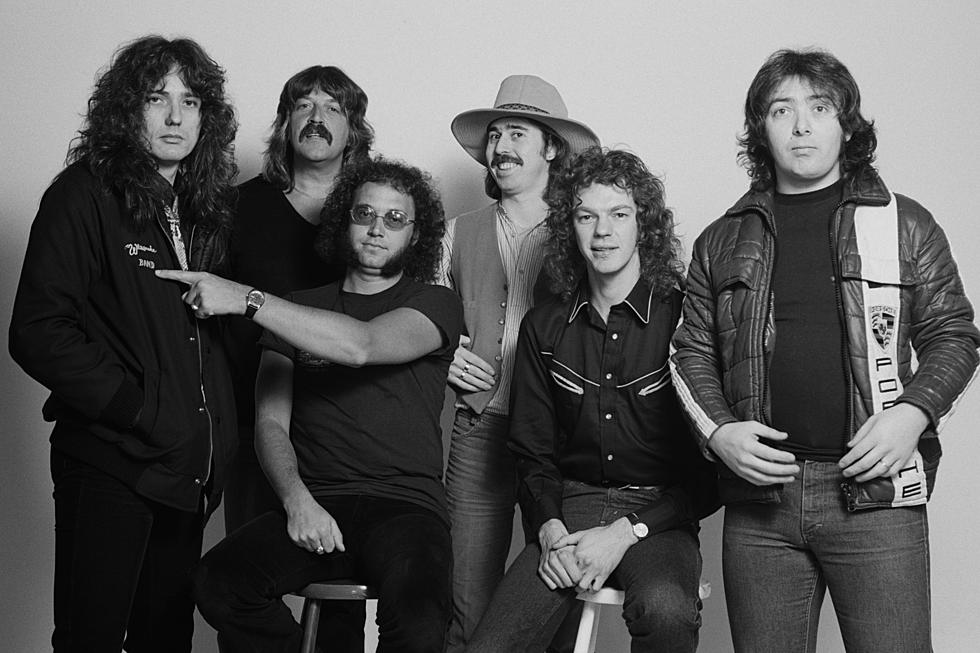
The Story Behind Every Song on the Rolling Stones’ ‘Let It Bleed’
No one could have blamed the Rolling Stones if they phoned one in with their eighth LP, 1969's Let It Bleed. Keith Richards, Mick Jagger and Brian Jones had all faced recent legal woes, and the latter guitarist — the band's co-founder and wizard on non-rock instruments — was disappearing into the haze of substance abuse and erratic behavior that led to his eventual firing.
But they used that tumultuous atmosphere to their benefit, crafting a dark near-masterpiece full of unimpeachable career highlights like the bookend classics "Gimme Shelter" and "You Can't Always Get What You Want."
The sessions technically launched in November 1968 — one month before the release of their previous record, Beggars Banquet — with initial recording for "You Can't Always Get What You Want." But their proper, nine-month run began in February 1969, as Richards, Jagger, bassist Bill Wyman and drummer Charlie Watts teamed again with producer Jimmy Miller in London and Los Angeles.
By this point, Jones was essentially a ghost in the studio: He's credited on only two tracks (congas on "Midnight Rambler," autoharp on "You Got the Silver"), and he's mostly remembered for hanging out pointlessly in the wings. “He was just sort of lying in the corner on his stomach, reading an article on botany,” session player Al Kooper told Rolling Stone. (The guitarist's eventual replacement, Mick Taylor, wouldn't be fully integrated into the band until 1971's Sticky Fingers. But he did appear on two Let It Bleed songs: "Country Honk" and "Live With Me.")
Given the band's lavish taste in cuisine and drugs, there were plenty of other, more pleasant distractions. “There was a great deal of cannabis and the like passed around,” Kooper added. "At dinnertime, these two vans pulled up and put out a spread of food the likes of which I have never seen in a studio: lamb chops, curried dishes, class-A desserts. A pot smoker’s dream!”
Despite the obstacles, the Stones did wind up the finish line, issuing Let It Bleed in December. And decades later, it remains one of their most beloved recordings — worthy of a deep-dive into the stories behind each song.
"Gimme Shelter"
What a groovy way to watch the world burn. "Gimme Shelter" opens with Richards' tumbling, intricate riff; a high, mysterious coo; and the scrape of producer Jimmy Miller's güiro. It hardly sounds like an "apocalypse," the "end-of-the-world song" that Jagger described to Rolling Stone. That changes when Jagger struts into the mix, warning of storms, war, rape and murder.
The heavy track — which we ranked No. 1 on our Top 100 Rolling Stones Songs and our third-best classic rock cut ever — didn't start out as a reflection on the menace of modern man. The original seed grew from the threat of nature.
"I had been sitting by the window of my friend Robert Fraser’s apartment on Mount Street in London with an acoustic guitar when suddenly the sky went completely black and an incredible monsoon came down. It was just people running about looking for shelter — that was the germ of the idea," Richards told Harper's Bazaar. "We went further into it until it became, you know, rape and murder are ‘just a shot away.’"
The arrangement was a product of invention and necessity. Since Jones was unable to contribute to the sessions, Richards wound up playing both rhythm and lead guitar, joined by Wyman's bass, Watts' drums (including his iconic snare-tom chorus fills), Miller's assorted percussion, Nicky Hopkins' piano and, in the band's most genius move, a soulful guest vocal from Merry Clayton.
"When we got to Los Angeles and we were mixing it, we thought, 'Well, it'd be great to have a woman come and do the rape/murder verse,' or chorus, or whatever you want to call it," Jagger told NPR. "We randomly phoned up this poor lady [Clayton] in the middle of the night, and she arrived in her curlers and proceeded to do that in one or two takes, which is pretty amazing. She came in and knocked off this rather odd lyric. It's not the sort of lyric you give everyone — 'Rape, murder / It's just a shot away' — but she really got into it, as you can hear on the record. She joins the chorus. It's been a great live song ever since."
It's an anthem onstage and on record, but its dark message gives the song a deeper resonance. "It was a very moody piece about the world closing in on you a bit," Jagger said. "When it was recorded, early '69 or something, it was a time of war and tension, so that's reflected in this tune."
"Love in Vain"
We can trace much of classic rock's DNA back to one man, Delta blues pioneer Robert Johnson, who only recorded 29 songs before his death at age 27 in 1938. In particular, the singer-guitarist wound up a prime inspiration for the '60s British blues boom, leading to a string of revamped cover versions (Cream's "Crossroads") and moments that blurred the line between tribute and rip-off (Led Zeppelin's "The Lemon Song"). On Let It Bleed, the Stones took a stab at Johnson's "Love In Vain," with Jagger barking over Richards' lonesome acoustic blues riff and slide guitar.
"We changed the arrangement quite a lot from Robert Johnson’s," Jagger told Rolling Stone. "We put in extra chords that aren’t there on the Robert Johnson version. Made it more country. And that’s another strange song, because it’s very poignant. Robert Johnson was a wonderful lyric writer, and his songs are quite often about love, but they’re desolate."
Early editions of the LP credited the song to "Woody Payne," leading to a copyright battle over the song's public domain status. They probably would've been better off writing something new — unlike, say, Cream's bulldozer "Crossroads," this one's a bit lackluster.
"Country Honk"
The Stones recorded two versions of their 1969 hit "Honky Tonk Women," but they should have only bothered with one. The first, issued as a stand-alone single, is a twangy, greasy rocker with the appropriate amount of swagger for a song about a "gin-soaked, bar-room queen in Memphis." Ironically, it wasn't the style they envisioned: The song was inspired by the vintage country of Hank Williams and Jimmie Rodgers, but it only wound up in electric mode after the addition of Taylor. "It got turned around to this other thing by [Taylor], who got into a completely different feel, throwing it off the wall another way," Richards told Crawdaddy in 1975, according to the 2001 book Rolling Stones: Rip This Joint: The Stories Behind Every Song.
Taylor has denied exerting a major influence over the track, but either way, we should be happy it happened. The Stones went back to their original vision for Let It Bleed's "Country Honk," a haggard take that sounds like it was captured by a solitary microphone during a booze-filled backyard cookout. There's a blindingly loud violin, just slightly out-of-tune acoustic guitars and a tentative Jagger vocal that lacks his usual gusto. It's the lone legit weak spot on a near-perfect record.
"Live With Me"
The snarling "Live With Me" revolves around a funky bassline tracked by Richards, not Wyman. (It also features Bobby Keys on sax and the twin pianos of Hopkins and Leon Russell.) But its most notable feature is the guitarist's dual interplay of with the newly installed Taylor, who contributed a few overdubs at London's Olympic Studio.
"That was kind of the start of that particular era for the Stones, where Keith and I traded licks," Taylor reflected in the 2013 book Rocks Off: 50 Tracks That Tell the Story of the Rolling Stones. "He'd sometimes play rhythm, I'd sometimes play rhythm, but on stage there'd always be quite a lot of lead guitar playing, which I'd do most of."
Richards fondly reflected on the duo's chemistry in the 2012 documentary Crossfire Hurricane: "To me, the real interest in playing guitar is to play guitar with another guy," he said. "Two guitars together, if you get it right, it can become like an orchestra. And Mick Taylor is a virtuoso."
"Let It Bleed"
According to legend, the Stones spent so long working on the record's folky title track, Richards' fingers actually started bleeding. It's an amusing anecdote since "Let It Bleed" is such a simple song, built on a straight-ahead, three-chord acoustic strum and Ian Stewart's honky-tonk piano — not exactly the shred-fest one might assume, given the backstory.
The raw performance also doesn't scream "recorded until perfected." The band is just barely pulling it together here: Watts' snare often drags behind the beat, and the chord change at 2:03 is a near train-wreck. But it's a savory form of sloppiness, tied together by Jagger's juvenile drug and sex references ("We all need someone we can cream on").
"Midnight Rambler"
The song does indeed ramble — exquisitely so. At just under seven minutes, it builds from a standard boogie into a blues-rock epic full of surprising touches: woozy slide-guitar counterpoint, swinging hi-hat triplet grooves and a lumbering, John Bonham-esque drum beat that completely changes the feel past the two-minute mark. (Though Jones is credited on congas, no such instrument is audible at any point.)
"That's a song Keith and I really wrote together," Jagger told Rolling Stone. "We were on a holiday in Italy. In this very beautiful hill town, Positano, for a few nights. Why we should write such a dark song in this beautiful, sunny place, I really don't know. We wrote everything there – the tempo changes, everything. And I'm playing the harmonica in these little cafes, and there's Keith with the guitar."
In a separate Rolling Stone interview, Richards called the piece an "experiment," suggesting that the song "[comes] through better live" after being developed more. "Sometimes when you record something you go off half-cocked because maybe you haven’t ever played it live," he said. "You’ve just written it and you record it. From then on you take it and keep on playing it and it gets different."
"You Got the Silver"
This country-tinged love song marks Richards' first full lead vocal, and he brings a charming, Bob Dylan-ish whine to the laid-back cut. Upon close examination, it's one of the album's least interesting moments — but any melodic deficiencies are masked by the robust arrangement, which dips back ever-so-slightly into psychedelia, as breezes of reverb-y, reversed guitar waft around Richards' acoustic guitar and Hopkins' tranquil piano.
The Stones didn't perform "You Got the Silver" onstage until 1999, but it's become an unexpected semi-staple in the years since. “[Richards] didn’t realize how much people like that song,” current guitarist Ron Wood told Rolling Stone. “I’ve kind of reintroduced that, and it’s gone down really well.”
"Monkey Man"
This cinematic soul-rocker, which also originated during the Richards-Jagger Italian holiday, finds the frontman hollering John Lennon-styled surrealism ("I'm a flea-bit peanut monkey," "I'm a cold Italian pizza / I could use a lemon squeezer") over a maximalist arrangement that includes Wyman's glistening vibraphone.
The track, probably the wildest moment on Let It Bleed, never became a live staple, though the Stones did play it frequently during their mid-'90s Voodoo Lounge tour. It's appeared occasionally in their sets over the years, most recently on their 2019 No Filter trek.
"You Can't Always Get What You Want"
After a torrent of ragged blues riffs and sneering folk-rock, the Stones end Let It Bleed with a sublime mini-symphony. "You Can't Always Get What You Want" ranks among the band's elite songs (we named it their fourth-best in 2012), even if its quirky, grandiose arrangement — including thickets of percussion, gospel backing vocals, a melancholy French horn theme and the mournful tones of the London Bach Choir — made it an unlikely way to close out the decade.
The song, which many critics have accurately described as the Stones' resilient answer to the Beatles' "Hey Jude," originated from a simple acoustic guitar progression Jagger later referred to as "one of those bedroom songs." But the track became challenging to record as the band's ambitions swelled, even down to the funky drum accents suggested (and eventually performed) by producer Jimmy Miller. "Charlie couldn't play the groove and so Jimmy Miller had to play the drums," Jagger noted. "I'd also had this idea of having a choir, probably a gospel choir, on the track, but there wasn't one around at that point. Jack Nitzsche, or somebody, said that we could get the London Bach Choir and we said, "That will be a laugh.'"
The result of their effort was a top-tier masterpiece, highlighted by a dynamic arrangement and symbolic reflections on the madness of the passing decade. But it continues to resonate, Jagger told Rolling Stone, because of its simplest components. "People can identify with it," he said. "No one gets what they always want."
See Keith Richards Through the Years
More From Highway 98.9




![Job Hunting? The Caddo Sheriff’s Office May be for You [VIDEO]](http://townsquare.media/site/180/files/2019/11/caddo-sheriff.png?w=980&q=75)





